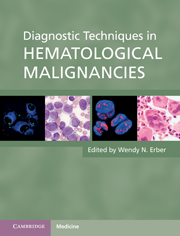5 - Molecular genetics
from Part 1 - Diagnostic techniques
Published online by Cambridge University Press: 06 December 2010
Summary
Introduction
Molecular genetic-based methods are now an integral component in the diagnostic workup of hematological malignancies. This will be evident in the clinical Chapters 7–15, each of which includes discussion of the use of molecular diagnostic methods in the analysis of acute and chronic lymphoid and myeloid neoplasms. This is a major change which has taken place over the past 10 years. Molecular genetics has moved from research-based applications and the simple amplification and detection of an abnormal gene to highly sensitive and reproducible monitoring of minimal residual disease. This chapter describes some of the types of PCR-based assay methods commonly used in the analysis of hematological malignancies, demonstrates their strengths and gives some clinical applications.
Polymerase chain reaction
Principles of PCR amplification
Polymerase chain reaction (PCR) is the method by which DNA is amplified to generate thousands of copies of the same sequence. The principle is the utilization of repeated cycles of heating and cooling (thermal cycling) and a thermostable DNA polymerase to replicate DNA. The heat physically separates the double strands of DNA and replication occurs at the cooler temperatures. The cycles of heating and cooling are repeated over and over, allowing primers to bind to the original DNA sequences of interest and to newly synthesized sequences (Figure 5.1). The enzyme, Taq polymerase, will again extend primer sequences. This cycling of temperatures results in copying and then copying of copies, and so on, leading to an exponential increase in the number of copies of specific DNA sequences.
- Type
- Chapter
- Information
- Diagnostic Techniques in Hematological Malignancies , pp. 90 - 110Publisher: Cambridge University PressPrint publication year: 2010
References
- 1
- Cited by



